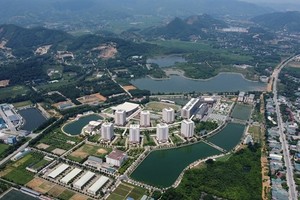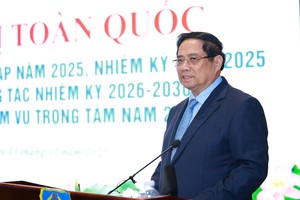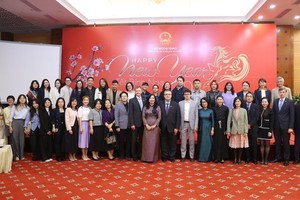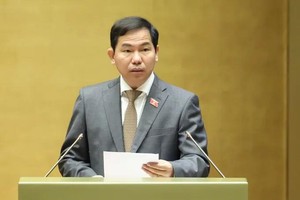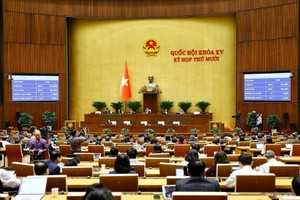 |
Citizens coming for administrative procedures at the Center for Public Services of Thu Duc City |
Referring to practical experience gained from the merger between Dong My Ward and Hai Dinh Ward of Dong Hoi City in Quang Binh Province, Chairman Nguyen Huu Thuyet of the People’s Committee of the new Dong Hai Ward commented that the home affairs division should first review the staff status in all state offices to eliminate excessive officials and keep experienced ones for smooth operation and sustainable development.
Similarly, Chairman Nguyen Quang Trung of the Hai Ba Trung District People’s Committee (in Hanoi) shared that the first step in this administrative unit rearrangement is extremely tough. It is necessary to focus on meaningful policies for the excessive staff and part-time officials, along with additional beneficial ones for these laborers. His district also cooperated with other state agencies in Hanoi to help concerned citizens adjust their identification and land-related papers.
To address the issue of laying off excessive staff after the rearrangement so as to ease their mind and not to negatively affect their life, besides adopting the common mechanism on staff streamlining, there must be additional policies and satisfactory support.
A comprehensive review of the responsibilities of all retained officials should also be done to adjust their duties according to their own capacity so that they can perform their best at work, either in the current or new places.
In the recent meeting to launch the plan for administrative unit rearrangement, Prime Minister Pham Minh Chinh stressed that there must be shared understanding of the plan, along with a strong determination and transparent focused actions without haste and perfectionist thinking.
The first and foremost requirement of this plan is to ensure stability in the whole political system and the life of all concerned citizens. Hence, the propaganda task is of extreme importance to form a high awareness level as well as consensus in the community.
Minister of Home Affairs Pham Thi Thanh Tra stated that administrative unit rearrangement is a huge and complicated yet critical task which deeply affects the whole society, including civil servants, public employees, and citizens. A consensus among the public on this matter is needed more than ever to ensure consistency from the central to local levels.
The Party’s Committee at grassroots levels and the local authorities should first direct this rearrangement so that the task is done carefully, comprehensively, and consistently. The job should strictly observe all introduced criteria and consider all specific conditions of each locality in accordance with the resolution of the NA’s Standing Committee on administrative unit rearrangement at district and ward levels in the 2023-2030 period.
Architect Tran Ngoc Chinh – Chairman of the Vietnam Urban Planning and Development Association (VUPDA) – commented that this rearrangement has attracted much attention of the whole society as it directly relates to their life. It is, therefore, necessary to collect and then review all of their opinions. Take Hoan Kiem District in Hanoi as an example. Obviously, this merger is not merely mechanical but must ensure to satisfy various goals and address existing problems while save space for further development in the future.
NA Delegate Tran Quang Minh voiced that the current socio-economic conditions in Vietnam have changed a great deal, and IT developments in the digital era has allowed more convenience in carrying out administrative procedures. Localities need to have enough space to promote regional advantages and reduce administrative focal points at commune and district levels. A merger must consider the master planning, the real socio-economic, security status of each place, and a long-term vision to better attract investment as well as more effectively promoting the local strengths.
At its 4th session, the 15th National Assembly approved the national master planning. Until now, several provinces and cities have finished their own planning, an important foundation for newly arranged administrative units to have motivation for development.
To minimize inconvenience for businesses and citizens, all state agencies and departments should actively and flexibly review any legal regulations related to their fields in order to offer timely instruction to the People’s Committees of newly formed districts and wards so that they can help individuals, organizations to adjust identification papers free of charge. Any valid papers issued by the old administrative units can still be in use.
Minister Tra added that the rearrangement plan in the 2023-2030 period is associated with the restructuring of the state apparatus and staff streamlining, salary policy reforming, quality improvement of civil servants and public employees in the political system. The final goal is to have smoother and more effective local authorities.
Minister of Home Affairs Pham Thi Thanh Tra said that by 2025, any districts and communes with both a natural surface area and population under 70 percent of the standard; any districts with both a natural surface area under 20 percent and population under 200 percent of the standard; any communes with both a natural surface area under 20 percent and population under 300 percent of the standard will have finished their rearrangement.
By 2030, any other districts and communes with both a natural surface area and population under 100 percent of the standard, any districts with both a natural surface area under 30 percent and population under 200 percent of the standard, any communes with both a natural surface area under 30 percent and population under 300 percent of the standard will have completed their rearrangement.
At present, 58 localities nationwide have to review their 33 districts and thousands of communes for this rearrangement plan. 48 out of the 58 areas above have sent their report to the Home Affairs Ministry.
